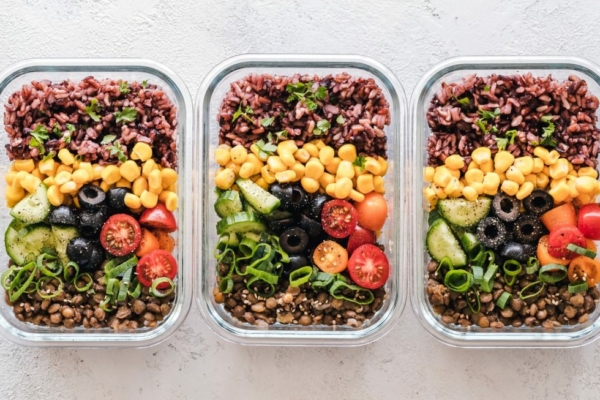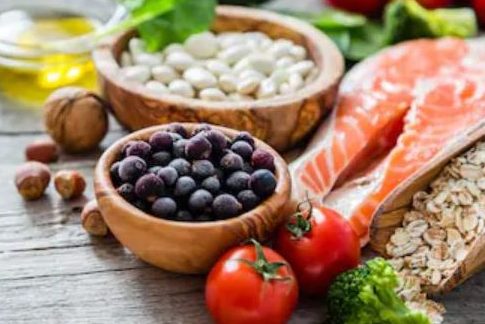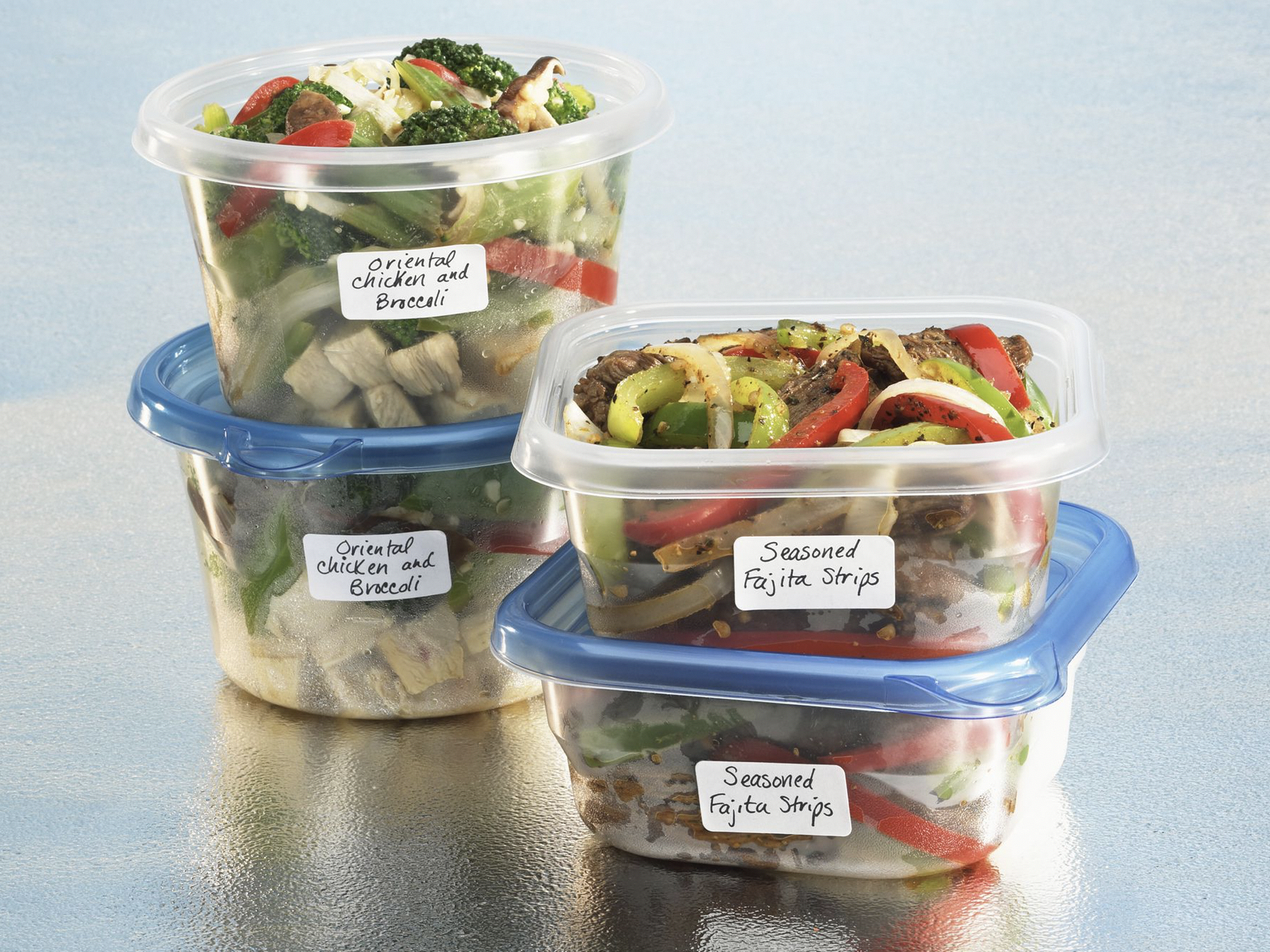Meal Prep Bootcamp: The Tips & Tricks to Reach Your Goals
by Cameron – Friday, 24. July 2020
Abs are made in the kitchen
Have you ever heard the saying “abs are made in the kitchen”? It’s an overlooked fact that your nutrition and consumption are the most important factor in losing weight, gaining muscle, and maintaining your overall health. Classes at Velocity will help you tone and build muscle while losing fat, but 70% of the physical progress you’ll see is done through nutrition!
Set yourself up for success with meal prep
People associate “diet” with having to eat less than a comfortable amount of food, and that is simply not true. Nor does it mean you need to have to painstakingly avoid comfort foods. The best way to accomplish what we want without torturing ourselves with temptation is with meal prep. Pre-planning our meals helps us stay focused on our goals, makes it easier to choose the right foods for us, and saves us time in our busy schedules. Let’s dive into the intro course on meal prep and nutrition.

There’s a lot of misinformation out there, and we are still learning and revising our understanding of how different compounds affect the body in regards to health and nutrition. In this blog, we’ll stick to the basics of how to best prepare your meals and set yourself up for success.
Find Your Macros and Calorie Counts
This is not an essential part of your meal prep program, but it is a very helpful way to design your meals and better understand what your body needs. Macros, or macronutrients, are the three categories of nutrients that provide you with most of your energy: protein, carbohydrates, and fats. The amount of each that you need can be determined through your BMI, body fat percentage, height, weight, activity level, and age. There are many sites out there that can help you estimate how much is best for you, but the key is to find the right ratio of each for the type of diet you would like to participate in and your body type. Counting macros can help you lose fat and build muscle because you have a guideline for which proportions of foods work best for each meal. Of course, this is oversimplified. It’s important to keep a strong balance of foods that contain a variety of antioxidants, vitamins, minerals, and phytochemicals as well.
Calorie counting can be a powerful tool as well for one reason. Calorie counting can be a useful tool as well, but is rather complex since no one calorie is the same. On a basic level, in order to lose weight or fat, one should eat fewer calories than you burn. This doesn’t mean you have to starve yourself! In fact, eating too little can increase cortisol levels, making you more hungry and at the same time increasing belly fat. The key is to find a healthy balance of nutrients that promote decreased inflammation and an increased metabolic rate. Diets with high protein levels, low sugar, and unrefined carbs can be a recipe for success. Participating in cardio and strength exercise will make up the difference, allowing you to consume more calories while maintaining higher metabolic production, meaning toned muscle and less fat.

What to Shop for
The best way to start meal prep is to make sure you have a well-stocked pantry. You want to have food you can use for many different meals. These foods ideally also have a longer shelf life to complement your fresh ingredients. Canned products like beans, tomatoes, tuna, chickpeas, and chiles are healthy foods that can be used in many different meals. Buying healthier carbohydrates like lentils, quinoa, brown rice, and whole-grain pasta can last a long time in the cabinet and be used in all sorts of dishes. When buying vegetables, try to choose ones that are versatile such as courgettes, broccoli, sweet potatoes, and onions. Fruits that are high nutrients such as citrus fruits, bananas, apples, blueberries, strawberries, and avocado are great to utilize in a lot of dishes. Premade stocks, bouillons, sauces, and spices can also save you time and build your meals with flavor.
For those who eat meat, the best way to lower your caloric intake while getting the most protein possible, look for lean protein like skinless chicken and turkey breast, egg whites, lean beef like loin and round cuts, white-fleshed fish, and shellfish. For those who don’t eat meat, there are still lots of great protein options. Greek yogurt, beans, peas, quinoa, lentils, chickpeas, tofu, seitan, spirulina, nuts, and protein bread are all great sources to choose form.
Once you’ve gathered all the essentials, it’s time to start cooking and assembling! Here are some ideas for how to maximize your experience.

Tips and Tricks for Meal Prep
1. Plan Ahead
Prep for the Meal Prep! Have an idea of what you want for food and how it fits into your diet for multiple meals a day. It’s a good way to keep you focused at the grocery store and to be able to establish themes or flavors for the food that are going to inspire you to continue toward your goals! Healthy doesn’t have to mean bland, a little research can go along way for your tastebuds.
2. Incorporate Convenience
Having pre-made sauces, marinades, and stocks can save you a lot of time and effort while making sure your meals are restaurant ready. Speed up the process for yourself so you’re not working through the whole weekend.
3. Multitask
Try to find recipes that use the same base ingredients or cooking methods. While waiting for different items to finish, it gives the perfect opportunity to prepare vegetables and sauces. Instant pots work great for “set it and forget it” recipes. The more you have going at once, the less time things take.
4. Long to Short
Start with the recipe that takes the longest to cook or prepare. This gives you the ability to prepare other food while your oven recipes or slow cooking pots are finishing up. This saves you time and makes sure things aren’t sitting out for very long.

5. No One-Size-Fits-All
There’s no perfect meal, and it would certainly be quite a boring process if everything you ate was the same. Manipulate your meals to fit your goals. If you want to gain muscle, high protein, and carb diets that are heavy in calories might be perfect for you. If you are looking to tone and lose fat, it may help to lower your carb levels.
6. Portion Control
Understand how much you should have of the food you want to consume. 4 oz. of chicken might be just enough to hold you through lunch. Having balanced meals throughout the day can help you from getting hungry, improve metabolism, and prevent fatigue. It can be helpful to buy pre-made boxes that help you map out how much of each item you want to meet your goals.
7. Don’t Overdo It!
A meal prep designed for 7 days a week and 3-5 meals a day can be exhausting. Feeling the need to design all sorts of different dishes can have the same effect. Start simple and only do what you deem necessary. Maybe you begin by just preparing your weekly lunches, and go from there. The goal is to get into an effective routine, and if you are overtired after the first week it’s going to be incredibly difficult to continue your motivation.
8. Consider Multi-day Prep
This is another option when it comes to preventing yourself from being overwhelmed. Instead of trying to do all your weekly meals on Sunday, consider dividing the workload into two days. For one, your food will be fresher, and second, you will save yourself the stress of feeling like it all needs to be done at once. Meal prep is designed to make your life easier in the long run and to help you stick to your health goals. If you have any questions on your journey feel free to ask us for advice, and we’ll continue to help you be the strongest, happiest, and healthiest you through our classes here at Velocity.



INSTRUCTOR SPOTLIGHT: AARON
/in Health, Lifestyle, Rides/by AdminInspirational Swiss Food Blogs
/in Health, Lifestyle, Living in Zurich/by AdminHow to Avoid a Winter Workout Rut
/in Health, Lifestyle, Rides/by Admin